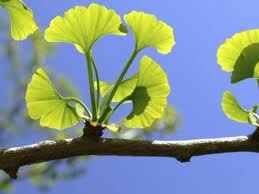Ginkgo
G. biloba, also called the Maidenhair Tree because its leaves closely resemble those of the Maidenhair Fern, is a deciduous (leaf-losing) tree that is hardy in the North. The Ginkgo hasn't been found growing in the wild, but it is thought to have originated in China. In the Orient, this tree may grow up to 100 feet high with a circumference of 18 to 20 feet. The leaves of this tree are interesting and unique from any other tree. They are fan-shaped, sometimes having 2 lobes, leathery and smooth. They are bright green during the summer, turning gold before dropping in the fall. Fine veins radiate out into the fan-like blades. Male (staminate) and female (pistillate) flowers grow on different trees. The fruits resemble small plums when ripe. They are about �- to �-inch in diameter. They contain a large, smooth, silvery-white seed in the center. When the fruits begin to decay after they've fallen, they emit an unpleasant odor. The fruits and roasted pits are valued by the Oriental people. The name Ginkgo comes from the Chinese and means "silver fruit " or "white nuts." Ginkgo trees grow well in the city, being able to tolerate city smoke and dust. It isn't usually vulnerable to fungi, insects or damaged by storms.
Pot Cultivation
This tree will thrive on moist, fairly fertile soil.
Propagation
Seeds may be sown singly in small containers. They need to be planted out before they become pot bound.
 |
G. biloba. |
VARIETIES
G. biloba.

